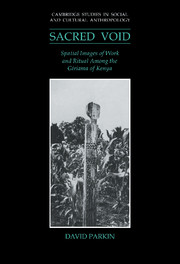Book contents
- Frontmatter
- Contents
- List of illustrations
- Preface
- Introduction
- 1 Fantasies of the west
- 2 Western Kaya, sacred centre
- 3 View from the west: cattle and co-operation
- 4 From west to east: the works of marriage
- 5 Spanning west and east: dances of death
- 6 Alternative authorities: incest and fertility
- 7 Alternative selves: invasions and cures
- 8 Coastal desires and the person as centre
- Conclusion
- Appendix 1 Three ecological zones and demographic features of southern Kilifi District
- Appendix 2 Giriama kinship and affinal terms
- Appendix 3 Giriama cattle terms
- Appendix 4 Giriama patri-clan structure
- Bibliography
- Index
- Cambridge Studies in Social and Cultural Anthropology
Appendix 1 - Three ecological zones and demographic features of southern Kilifi District
Published online by Cambridge University Press: 03 November 2009
- Frontmatter
- Contents
- List of illustrations
- Preface
- Introduction
- 1 Fantasies of the west
- 2 Western Kaya, sacred centre
- 3 View from the west: cattle and co-operation
- 4 From west to east: the works of marriage
- 5 Spanning west and east: dances of death
- 6 Alternative authorities: incest and fertility
- 7 Alternative selves: invasions and cures
- 8 Coastal desires and the person as centre
- Conclusion
- Appendix 1 Three ecological zones and demographic features of southern Kilifi District
- Appendix 2 Giriama kinship and affinal terms
- Appendix 3 Giriama cattle terms
- Appendix 4 Giriama patri-clan structure
- Bibliography
- Index
- Cambridge Studies in Social and Cultural Anthropology
Summary
Coastal strip. This is a mainly fishing and agricultural area which is at or slightly above sea level. It consists of wooded grassland up to about 10 kilometres inland, and often much less, before giving way to a mixture of forest and wooded grassland. Its rainfall is relatively high, especially south of Kilifi, and ranges from about 1270 to 1525 millimetres a year, sometimes a little less between Kilifi and Malindi.
The area includes settlement schemes and so-called squatter settlements formerly and in some cases still owned by Swahili and Arabs and occupied by Mijikenda who have migrated there sometimes recently and sometimes generations ago, and who are now being allowed legally to acquire rights of tenure. The coastal strip up to a distance of a few miles inland was under the suzerainty of the Sultan of Zanzibar but became part of Kenya at its independence in 1963.
From this time on, large numbers of up-country people from the Central, Nyanza and Western provinces of Kenya migrated to the coastal strip, principally to the town and surrounding district of Mombasa, but also to small towns along the line of road from Mombasa to Malindi and to settlement schemes newly established along the coast.
- Type
- Chapter
- Information
- The Sacred VoidSpatial Images of Work and Ritual among the Giriama of Kenya, pp. 232 - 235Publisher: Cambridge University PressPrint publication year: 1991



